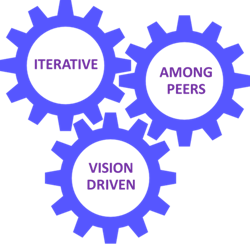When Ideation Is a Waste of Time
As an innovator, ideator and implementer, I trembled as I wrote that title. It’s blasphemy in our world. But it’s true! When ideation is done wrong, it’s simply a waste of time. In my 20 plus years in the innovation and strategy space, I have seen how ideation goes wrong and goes well.
Gone Wrong:
The commercial VP sends out a company-wide email. “From now on we will have a company-wide monthly ideation meeting. Bring your best idea and let’s discuss!” When this type of email is sent out, without any manager-led process to discuss new ideas and prepare to submit, no one contributes in the monthly meeting. Although there’s an opportunity to wow the leadership, the risk of “saying something dumb” is too great.
Goes Well:
A company tries crowd-sourcing. The commercial VP extends a company-wide request for a specific vision of a better state. Then, upon getting a few ideas by email, leadership creates multifunctional teams to come together to vet and rework a few that seem initially interesting. Here the company provided vision, and a set of peers to reimagine and rework the ideas. This is a safe and encouraging environment to noodle on ideas and develop some into something revolutionary. Since this is still a one-off activity, continuous improvement will come by going through the process again with a variation on the vision for focus.
Gone Wrong:
The commercial VP sends an email asking for all employees to submit ideas to the newly created idea box. Submission can be anonymous, so there’s no risk of “saying something dumb.” The Innovation team gets a ton of ideas, with no one to ask follow-up questions. The result is a confused and burdened Innovation team that feels more like a group of suggestion reviewers than passionate innovators.
Goes Well:
Senior leadership has developed a vision of the future, and communicated that vision and some of the background to the innovation team. The innovation team grabs additional peers throughout the organization and schedules a series of ideation sessions, moderated in different ways to get people talking, ideating and challenging one another. This process begins to fill the pipeline with projects (incremental and blue-sky) that help move the company toward the executive vision.
What is required to make ideation successful? Besides a good innovation team, ideation must be vision-driven, occur among peers, and be an iterative process. Here’s why.
Vision-driven
Iterative
Who creates these ideas? Really, anyone in an organization can ideate, although typically business, sales, technical and operations functions are the largest contributors. When an organization wants to “fill the pipeline,” it often puts out a company-wide ask or contest. These initiatives are fine to get the ideation ball rolling, but in itself an initiative doesn’t adequately “fill the pipeline.” Ideation isn’t a random idea or two from every other employee. Ideation is a messy, iterative process of brainstorming, building, narrowing and brainstorming – repeating this process continually. This first innovation step is crucial to have an innovation team work through as a team.
An innovation team (the one that does the ideating) must be a team of peers who are diverse, knowledgeable, passionate. This team must build trust within itself. The ideal size varies, but in general less than four people on a team doesn’t enable much diversity of thought, and more than 12 gets hard to facilitate and gain trust.
Among Peers
The ideation process isn’t about looking smart or impressing someone with a great idea. If done right, no idea can be attributed to one person because it is built upon and refined by others. Ideating is about pushing past the status quo and getting to the “better” idea or option. If every team member hasn’t said something “dumb” in pursuit of something better, the team hasn’t tried hard enough. By hearing the insights of others, developing and building upon others’ ideas, and challenging even one’s own ideas, the Innovation team goes through a robust ideation session resulting in ideas worthy of the pipeline. It’s not rocket science or a day-long session. It is simply continual discussion and assessment of the pipeline of “one-off” ideas. This process helps the team understand what is blue-sky versus process improvement and appropriately move a range of projects through the Innovation process.
Without a vision, without time to revisit and reimagine, without a hierarchy-free environment, ideation is surface level at best. When organizations try to move surface ideas through the innovation process, the projects often change without the benefit of robust challenge. The result can be stagnated sales, scope creep, extended development time, low/reduced sales, or no commercialization at all. By defining and enabling a team to ideate, you can speed up and increase the value of your innovation pipeline.
Renette Rier is a strategist, marketer, innovator and doer who helps private and public manufacturing companies turn insights into profit. With eight granted patents and over 20 years in Strategy and Innovation, she has made diapers drier, introduced healthier insulation and helped wood manufacturers run faster. She believes strategy and innovation are often made out to be overly complex and she is bent on changing that.

